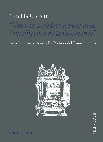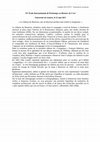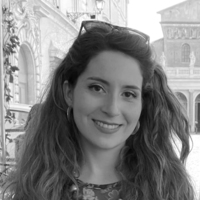Books by Camilla Ceccotti

La città di Poitiers dei primi decenni del XVI secolo spicca in territorio transalpino come capit... more La città di Poitiers dei primi decenni del XVI secolo spicca in territorio transalpino come capitale intellettuale e appare ricettiva alle tendenze artistiche rinascimentali. In questo contesto vengono eretti complessi residenziali che accolgono i modelli architettonici italiani, mediati dall’esperienza dei cantieri reali francesi, e che si distinguono grazie alle finestre d’angolo inquadrate dagli ordini architettonici. Muovendo da alcuni paradigmatici esempi locali, la trattazione evidenzia nelle soluzioni angolari rilevanti tematiche quali la continuità con il sistema gotico, il pragmatismo spaziale tipico del primo Rinascimento francese, la deformazione prospettica fondata sui principi dell’anamorfosi, le leggi della stereotomia tanto care a Philibert De L’Orme. Nelle fabbriche francesi analizzate l’angolo può essere interpretato quale elemento cardine di tutta la composizione, capace di rappresentare la storia e le trasformazioni dell’edificio medesimo.
Conference Organization by Camilla Ceccotti

Il tema delle fake news è di grande attualità e rilevanza per i mezzi e i fini con cui queste ven... more Il tema delle fake news è di grande attualità e rilevanza per i mezzi e i fini con cui queste vengono messe in circolazione: esse hanno il potere di alterare la realtà e di far circolare notizie prive di fondamento. Durante la giornata di studi si indagherà la modalità in cui l'alterazione del messaggio è stata assunta come verità nella storia dell'arte, ripercorrendo l'iter del processo artistico e la conseguente creazione delle fake news.
Comitato scientifico e organizzativo: Francesca Alberti (Académie de France à Rome – Villa Médicis), Camilla Ceccotti (Sapienza – Università di Roma e Sorbonne Université/RAHN), Patrizia Celli (Académie de France à Rome – Villa Médicis), Pauline Lafille (EPHE/Académie de France à Rome – Villa Médicis), Ginevra Odone (Université de Lorraine e Sapienza – Università di Roma/RAHN), Francesca Parrilla (University of Notre Dame Rome Global Gateway/RAHN) e Ariane Varela Braga (Zurich Universität/RAHN).
Conference Presentations by Camilla Ceccotti
Il tema delle fake news è di grande attualità e rilevanza per i mezzi e i fini con cui queste ven... more Il tema delle fake news è di grande attualità e rilevanza per i mezzi e i fini con cui queste vengono messe in circolazione: esse hanno il potere di alterare la realtà e di far circolare notizie prive di fondamento. Durante la giornata di studi si indagherà la modalità in cui l'alterazione del messaggio è stata assunta come verità nella storia dell'arte, ripercorrendo l'iter del processo artistico e la conseguente creazione delle fake news.
Talks by Camilla Ceccotti
Papers by Camilla Ceccotti

The Renaissance architecture in Poitiers : the classical architectural language in residential buildings between the end of the fifteenth and the of the sixteenth century
Notre travail de recherche se concentre sur l’apparition de la Renaissance à Poitiers et dans le ... more Notre travail de recherche se concentre sur l’apparition de la Renaissance à Poitiers et dans le territoire environnant entre la fin du XVe et le milieu du XVIe siècle. Nous en avons identifié les caractéristiques spécifiques dans le domaine de l’architecture en analysant notamment la typologie de bâtiment la plus diffusée dans le contexte urbain : celle de l’hôtel. Poitiers a connu une intense activité sur le plan architectural dès la fin du XVe siècle. Malgré cela, les études concernant le patrimoine bâti de la ville à l’époque de la Renaissance demeurent essentiellement peu développées comparativement à celles qui se penchent sur l’architecture du Moyen-Âge et du XVIIe siècle. La recherche que nous avons menée a tenté de combler cette « lacune » historiographique en analysant la production architectonique de la ville.Afin de comprendre les modalités de diffusion des modèles de la Renaissance italienne dans la région de Poitiers, nous avons examiné les principaux ensembles archite...

L’architettura del rinascimento a Poitiers : la ricezione del linguaggio architettonico all’antica negli edifici residenziali tra la fine del quattrocento e la metà del cinquecento
Notre travail de recherche se concentre sur l’apparition de la Renaissance a Poitiers et dans le ... more Notre travail de recherche se concentre sur l’apparition de la Renaissance a Poitiers et dans le territoire environnant entre la fin du XVe et le milieu du XVIe siecle. Nous en avons identifie les caracteristiques specifiques dans le domaine de l’architecture en analysant notamment la typologie de bâtiment la plus diffusee dans le contexte urbain : celle de l’hotel. Poitiers a connu une intense activite sur le plan architectural des la fin du XVe siecle. Malgre cela, les etudes concernant le patrimoine bâti de la ville a l’epoque de la Renaissance demeurent essentiellement peu developpees comparativement a celles qui se penchent sur l’architecture du Moyen-Âge et du XVIIe siecle. La recherche que nous avons menee a tente de combler cette « lacune » historiographique en analysant la production architectonique de la ville.Afin de comprendre les modalites de diffusion des modeles de la Renaissance italienne dans la region de Poitiers, nous avons examine les principaux ensembles archite...
Maurizio Gargano (Università degli Studi "Roma Tre") Paper title: "Architettura e opere pubbliche... more Maurizio Gargano (Università degli Studi "Roma Tre") Paper title: "Architettura e opere pubbliche tra Magnificentia e Liberalitas: i papi e Roma nel Quattrocento"

« Le château de Bonnivet, une architecture perdue entre réalité et imaginaire. » Le château de Bo... more « Le château de Bonnivet, une architecture perdue entre réalité et imaginaire. » Le château de Bonnivet, résidence située dans la campagne à nord de Poitiers, a finalement retrouvé sa place dans l'histoire de la Renaissance française, grâce aux études récentes de Jean Guillaume (2006). Par ses dimensions exceptionnelles, la qualité de son décor sculpté, les solutions constructives adoptées, l'édifice s'affirma comme le modèle pour le renouvellement du style architectural dans l'Ouest de la France dans les années 1510-1520. De ce complexe, malheureusement détruit au fil des siècles, aujourd'hui n'en survivent que de rares vestiges. Ainsi, la connaissance de cet extraordinaire château, précurseur de Chambord et comparable aux résidences de Blois, d'Azay-le-Rideau et de Chenonceau, doit surtout s'appuyer sur de nombreux témoignages écrits et iconographiques. Dans la troisième partie de la première édition du « Gargantua », François Rabelais, pour donner la mesure de la splendeur de son abbaye utopique de Thélème, affirmait qu'elle était « cent foys plus magnificque que n'est Bonnivet ». D'ailleurs, dans la création de ce complexe idéal, Rabelais s'inspira certainement à Bonnivet dont il adopta son élément le plus original, l'escalier-loggia ouvert sur deux côtés. En 1665 John Lauder exprimait également son admiration pour cet escalier, qu'il définit « magnifique » et « très curieusement fait ». L'escalier raffiné, que se retrouve en outre dans un croquis – le seul témoignage graphique du château qui nous est parvenu – contenu dans le carnet de voyage de Claude Perrault, qui fit étape à Bonnivet en 1669 sur la route pour Bordeaux. Également intéressantes, même si pleines de fantaisie, sont les vues représentant l'ensemble architectural : celles réalisées au XVIIe siècle par Chastillon et Lapointe, ou celles dessinées au XIXe siècle par Hivonnait, Honoré et Puissilieux-Drausin. Sur la base des témoignages textuels et iconographiques, faisant la distinction entre données réelles et fantaisies d'artiste, on veut présenter une première hypothèse de restitution du complexe architectural, afin de rouvrir le débat et de lancer des recherches nouvelles sur le « plus superbe édifice qui soit en France s'il était achevé » (Brantôme 1665-1666).
Thesis Chapters by Camilla Ceccotti
in co-tutela con Sorbonne Université Disciplina: STORIA DELL'ARCHITETTURA Presentata e sostenuta ... more in co-tutela con Sorbonne Université Disciplina: STORIA DELL'ARCHITETTURA Presentata e sostenuta da Camilla CECCOTTI, XXX ciclo il 28 giugno 2018
Book Reviews by Camilla Ceccotti










Uploads
Books by Camilla Ceccotti
Conference Organization by Camilla Ceccotti
Comitato scientifico e organizzativo: Francesca Alberti (Académie de France à Rome – Villa Médicis), Camilla Ceccotti (Sapienza – Università di Roma e Sorbonne Université/RAHN), Patrizia Celli (Académie de France à Rome – Villa Médicis), Pauline Lafille (EPHE/Académie de France à Rome – Villa Médicis), Ginevra Odone (Université de Lorraine e Sapienza – Università di Roma/RAHN), Francesca Parrilla (University of Notre Dame Rome Global Gateway/RAHN) e Ariane Varela Braga (Zurich Universität/RAHN).
Conference Presentations by Camilla Ceccotti
Talks by Camilla Ceccotti
Papers by Camilla Ceccotti
Thesis Chapters by Camilla Ceccotti
Book Reviews by Camilla Ceccotti
Comitato scientifico e organizzativo: Francesca Alberti (Académie de France à Rome – Villa Médicis), Camilla Ceccotti (Sapienza – Università di Roma e Sorbonne Université/RAHN), Patrizia Celli (Académie de France à Rome – Villa Médicis), Pauline Lafille (EPHE/Académie de France à Rome – Villa Médicis), Ginevra Odone (Université de Lorraine e Sapienza – Università di Roma/RAHN), Francesca Parrilla (University of Notre Dame Rome Global Gateway/RAHN) e Ariane Varela Braga (Zurich Universität/RAHN).